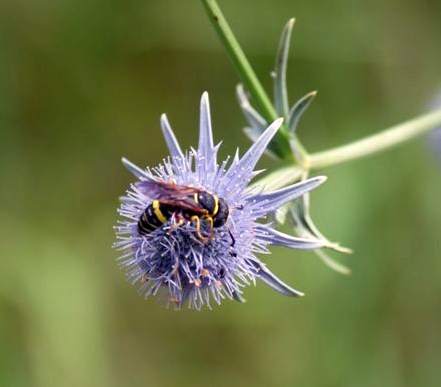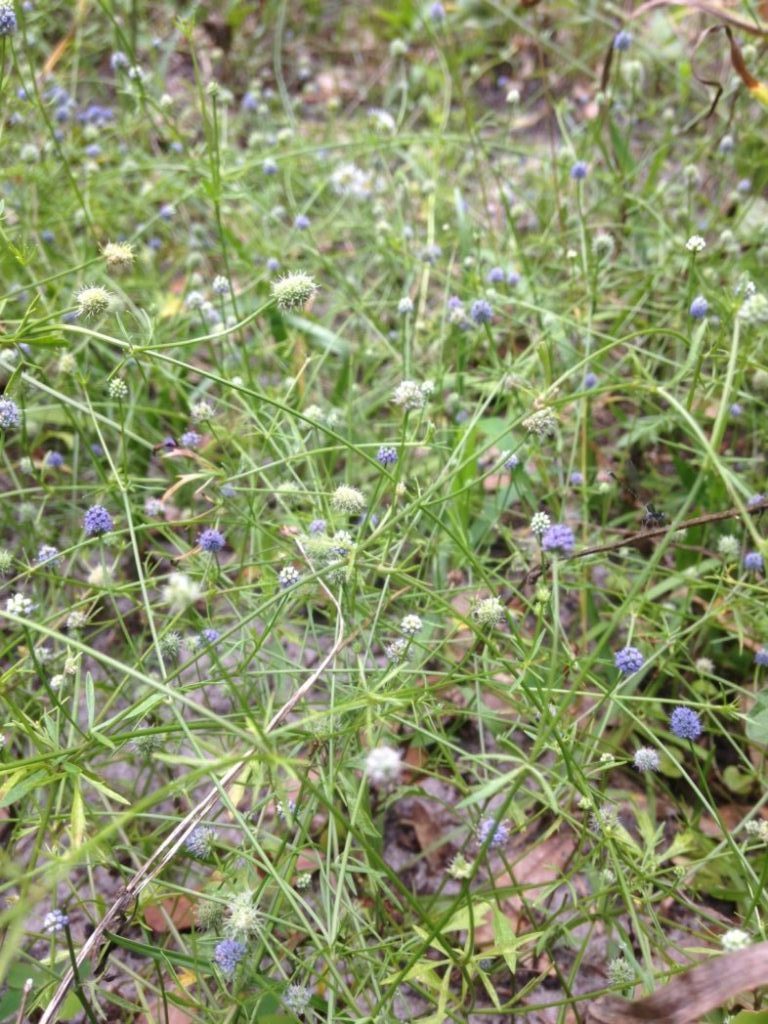Interesting Eryngiums
by Claudia Larsen
You may know this group of plants as “rattlesnakemasters.” Although not widely grown for landscape use, these perennial plants can be found across Florida in a variety of habitats. I love the diversity of these plants, as well as their interesting flowers that occur in summer and fall. They are always a little hard to describe because the heads are comprised of many tiny flowers, but their unique blooms, which may last for several months, are best captured in photos.
The Eryngium genus includes seven native Florida species, with one rare member, scrub Eryngium (Eryngium cuneifolium), found only in Highlands County. These plants are in the Apiaceae (or Umbelliferae, carrot and parsley) family, which makes them attractive to black swallowtail butterflies. They are mostly found in the southern United States, with the exceptions of E. aquaticum and E. yuccifolium, whose range extends to New Jersey. The name “rattlesnakemaster” is derived from stories that state the plant was effective in treating snakebites, but there is no scientific evidence of its efficacy.
Two rattlesnakemasters are found in wetter areas of north and central Florida. Both can be grown in home gardens that provide moist to wet soil. Eryngium aquaticum (pictured, right) as the name implies, is happy in pond and swamp habitats. It sports 6-8 inch linear leaves and a clumping 2-3 foot growth habit. It is also found in some roadside ditch areas that receive intermittent water. Large colonies provide a beautiful show of light blue, globose flowers that are attractive to butterflies and bees in summer. This plant does well in a garden that is sunny and moist, but it cannot take consistent water submersion.
Blueflower eryngo (E. integrifolium) is one of the showiest members of this family, with its numerous blue to violet flower stalks. It is easy to grow in pots, but may need extra watering. It can also grow directly in shallow water, or potted and submerged like blue flag iris or canna lily, making it useful for garden ponds where small plants are preferred. One drawback is that deer also think they are delicious with their large, oblong-lanceleaf succulent leaves.

There are several rattlesnakemasters that you might overlook because of their prostrate, ground-hugging habit. These have fine leaves and tiny blue flowers that appear in the leaf axils. These dainty plants grow where open areas allow the plant to spread horizontally. Baldwin’s eryngo (E. baldwinii) (pictured, below) accepts drier soil conditions, while creeping eryngo (E. prostratum) likes wetter pond and lake margins.
Fragrant eryngo (E. aromaticum) sounds lovely, but I cannot report on its actual smell, which is from the stiff, clefted leaves. Although reported as common, it is rarely found in gardens and nurseries because the plant is small and a bit floppy. It blooms in the fall in the drier scrub and sandhills of North and Central Florida.
Another common species is button rattlesnakemaster (E. yuccifolium), which is a summer bloomer and occurs throughout Florida. Eryngium yuccifolium (pictured right) is a charming plant. Its basal leaves remind me of a small yucca with sharp-looking needles on the leaf margins that are actually quite soft and harmless. In summer, three to four 15- to 30-inch stem spikes support spiny-looking white, round flower heads with silver lower bracts — the whole plants looks otherworldly, but is eagerly visited by small bees. The Xerces Society lists it as having special value for native bees and as an attractor of predatory or parasitoid insects that prey on pest insects. I try to plant them in groups of five or six to increase their visibility. They grow naturally throughout the state and prefer moderate soil moisture and light. A mature plant can reach 2-3 feet wide and tall. Wildflower author Dr. Walter Taylor states the Timucuan and Creek Indians used the roots for neuralgia and the leaves for dysentery. Some homeopathic references indicate this plant was used for treating urinary problems, but caution is always advised when using wild plant remedies.

I hope you will agree that Eryngos, as a group, hold an out-of-the-ordinary place in our inventory of Florida wildflowers. Keep a lookout for them in a park or wild area near you!
